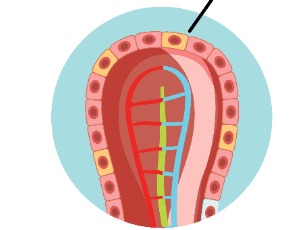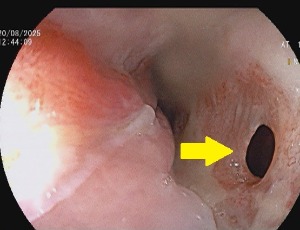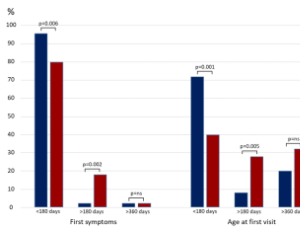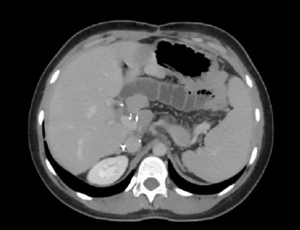Loading
Archives of Gastroenterology Research
ISSN: 2692-5427
Latest Articles
Gastrointestinal Reflux Related Aspiration (GRASP) and Airway Injury after Lung Transplantation: Insights into Pathophysiology and Role of Airway Biomarkers for Risk Stratification
Miguel M. Leiva-Juarez, MD, MSE , Frank D’Ovidio, MD, PhD
Lung transplantation remains the only long term treatment for end-stage pulmonary disease. The main limitation to allograft survival beyond the first year post transplant is development of chronic lung allograft dysfunction (CLAD). Among survivors, CLAD will develop in virtually all recipients and often will show signs of airway injury before any clinical manifestations appear. There is currently no specific treatment available and management depends largely on modification of risk factors. Recent efforts by our group and others have focused on understanding the underlying pathophysiology and development of clinical biomarkers to diagnose CLAD early and allow risk stratification before irreversible allograft injury.
Arch Gastroenterol Res, 2025, Volume 6, Issue 1, p1-7 | DOI: 10.33696/Gastroenterology.6.058
Disease Resolution after Cessation of Treatment in Patients with Eosinophilic Esophagitis
Qian Yuan , Jonathan N. Glickman , Wayne G. Shreffler
Eosinophilic esophagitis (EoE) is a chronic inflammatory condition of the esophagus. EoE is triggered in most patients by dietary allergens and mediated by type 2 immune responses. Over the past 3 decades, substantial progresses have been made in understanding EoE pathogenesis, management, and natural history. EoE affects children and adults, and the incidence and prevalence have increased over time. Untreated EoE can lead to severe complications including food impaction, small caliber esophagus, esophageal stricture, and esophageal perforation.
Arch Gastroenterol Res, 2025, Volume 6, Issue 1, p8-12 | DOI: 10.33696/Gastroenterology.6.059
Food Protein-Induced Allergic Proctocolitis (FPIAP): New Insights into Pathogenesis and Implications
Qian Yuan
Food protein induced allergic proctocolitis (FPIAP) is one of the earliest presentations of food allergies in infancy. It is a non-immunoglobulin E (IgE)-mediated condition. Although the inflammation is located at the rectosigmoid colon, clinical symptoms are not limited to mucousy, bloody stools and often include gastroesophageal reflux (GER), feeding difficulties, irritability and poor sleep.
Arch Gastroenterol Res, 2025, Volume 6, Issue 1, p13-18 | DOI: 10.33696/Gastroenterology.6.060
Abdominal Migraine in Children and Adolescents at a Single Tertiary Pediatric Gastroenterology Center: A Twelve-yea Experience on Clinical and Therapeutic Findings
Andréa Souza Hachem , Mary de Assis Carvalho , Gabriela Nascimento Hercos , Juliana Tedesco Dias , Carine Dias Ferreira de Jesus , Nilton Carlos Machado
Observational, retrospective cohort single-center study in consecutive cases of children and adolescents, referred for initial evaluation of chronic abdominal pain at the Pediatric Gastroenterology Outpatient Clinic. Inclusion criteria: Age between 4 and 17 years; Diagnosis of AM defined from structured questionnaires according to three consensus criteria (Rome III, Rome IV criteria, and The International Classification of Headache Disorders).
Arch Gastroenterol Res, 2025, Volume 6, Issue 1, p22-29 | DOI: 10.33696/Gastroenterology.6.062
norUDCA, a Novel Therapeutic Approach to the Disposal of A1- antitrypsin Mutant Z Proteins
Youcai Tang , Jeffrey H. Teckman
α1-antitrypsin deficiency (AATD) is a well-known genetic disease. No effective medical therapy is currently available for the liver disease. 24-norursodeoxycholic acid (norUDCA) has shown potent anti-cholestatic, anti-inflammatory, and anti-fibrotic properties in experimental and human cholestatic liver diseases. In this minireview, we discuss the role of exogenous norUDCA in reducing accumulation of a1-antitrypsin mutant Z proteins (AATZ) in the livers of PiZ mice and the in vitro model, HTOZ cells.
Arch Gastroenterol Res, 2025, Volume 6, Issue 1, p19-21 | DOI: 10.33696/Gastroenterology.6.061
A Case Series of Rapid Resolution of Pediatric Eosinophilic Esophagitis with Dupilumab Treatment as Demonstrated by Sedation-Free Transnasal Esophagoscopy (TN-Eso)
Arsal Khan , Isabel N. O’Connell , Wayne G. Shreffler , Joel A. Friedlander , Qian Yuan
Eosinophilic esophagitis (EoE) is a chronic inflammatory disease of the esophagus. Dupilumab, a treatment for EoE, requires an initial endoscopic evaluation no sooner than 12 weeks after initiation. As it is costly and pediatric patients often experience fear and pain associated with the injection, this could lead to non-adherence or premature cessation of therapy. Here, we report a case series, as part of a larger ongoing study, in which subjects demonstrated an earlier response to dupilumab.
Arch Gastroenterol Res, 2025, Volume 6, Issue 1, p35-39 | DOI: 10.33696/Gastroenterology.6.064
Cholestatic Pruritus: Current Management Approach and Emerging Therapies – Mini Review
Vishwajit Kode , Kidist K. Yimam
Cholestatic Pruritus is a phenomenon that occurs in disease processes that impair bile flow. This condition poses significant challenges to quality of life and is often underdiagnosed and undertreated. While the direct cause of cholestatic pruritus remains unclear, it likely involves a complex interplay between multiple biochemical pathways. Due to recent advances in diagnostic tools, more biochemical pathways of cholestatic pruritis have been discovered.
Arch Gastroenterol Res, 2025, Volume 6, Issue 1, p30-34 | DOI: 10.33696/Gastroenterology.6.063
Multifaceted Strategies for Managing Gastroesophageal Reflux Disease: A Study of Pharmacological and Non-Pharmacological Interventions
Akhilesh Kumar Kuril
Gastroesophageal Reflux Disease (GERD) is a chronic condition characterized by the retrograde flow of gastric contents into the esophagus, leading to symptoms such as heartburn, regurgitation, and potential esophageal injury. The pathophysiology of GERD primarily involves dysfunction of the lower esophageal sphincter (LES), impaired esophageal clearance, delayed gastric emptying, and transient LES relaxations. Additional contributing factors include hiatal hernia and obesity. The pharmacological management of GERD focuses on acid suppression and includes the use of proton pump inhibitors (PPIs), H2-receptor antagonists, antacids, and prokinetic agents.
Arch Gastroenterol Res, 2025, Volume 6, Issue 1, p45-52 | DOI: 10.33696/Gastroenterology.6.066
Upregulation of Downstream Angiogenic Genes Using mRNA for the Transfection of Transcription Factor Hypoxia Inducible Factor 1 Alpha: A Short Communication
Mirza Farhana Iqbal Chowdhury , Farzad Mokhtari-Esbuie , Amid Yazdani , Jakub Wlodarczyk , Azadeh Nourmohammadi , Anjira S. Ambade , John M. Abraham , John W. Harmon
Hypoxia-inducible factor 1-alpha (HIF-1α) plays a critical role in regulating cellular responses to low oxygen levels. In our study, we transfected HIF-1α mRNA into human dermal fibroblasts and assessed its biological activity by measuring the upregulation of downstream angiogenic genes, aiming to investigate the delivery mechanism of HIF-1α mRNA and its functional impact. In this short communication, we will describe our transfection methodology, present the results we obtained, and discuss the potential implications of these findings for future therapeutic applications.
Arch Gastroenterol Res, 2025, Volume 6, Issue 1, p40-44 | DOI: 10.33696/Gastroenterology.6.065
A Dual Mechanism Hypothesis for Celiac Disease: Intraluminal Pressure-Induced Villous Compression and Nitrate-Driven Motility Impairment
Nebyu Negash Woldeamanuel
Celiac disease (CD) is an immune-mediated enteropathy triggered by gluten ingestion in genetically predisposed individuals, resulting in villous atrophy, crypt hyperplasia, and mucosal inflammation. While immunologic mechanisms are well characterized, the role of mechanical and biochemical factors in disease onset remains underexplored.
Arch Gastroenterol Res, 2025, Volume 6, Issue 1, p57-59 | DOI: 10.33696/Gastroenterology.6.068
Endoscopic Palliation Therapy with Esophageal SEMS in a Case of Malignant Esophageal Stricture with Trachea-Esophageal Fistula
Aprajita Sharma , Anshul Bhateja
Esophageal cancer, a highly aggressive malignancy, frequently presents with advanced-stage dysphagia, significantly impacting patient quality of life. While surgical resection offers the best chance for cure in early stages, many patients are diagnosed with unresectable or metastatic disease, necessitating palliative interventions to alleviate symptoms.
Arch Gastroenterol Res, 2025, Volume 6, Issue 1, p78-80 | DOI: 10.33696/Gastroenterology.6.070
Food Protein-induced Allergic Proctocolitis with Breastfeeding or Formula Feeding at Symptoms Onset—A Ten-Year Experience at a Single Tertiary Center
Juliana Tedesco Dias , Mary Assis Carvalho , Gabriela Nascimento Hercos , Carine Dias Ferreira de Jesus , Thabata Koester Weber , Nilton Carlos Machado
Aim: This study evaluates the sociodemographic, clinical, and anthropometric data of infants diagnosed with Food Protein-Induced Allergic Proctocolitis (FPIAP), categorized as exclusively breastfeeding or formula feeding at the onset of symptoms. This division allows us to compare the effects of different feeding on the development of FPIAP. Methods: This retrospective, observational, single-center study included infants ≤36 months diagnosed with FPIAP. Exclusion criteria were chronic morbidities to ensure a focused study population.
Arch Gastroenterol Res, 2025, Volume 6, Issue 1, p86-94 | DOI: 10.33696/Gastroenterology.6.072
Liver Transplantation in an Adolescent Patient Post Extended Right Hepatectomy for Undifferentiated Sarcoma
Pablo Magaña-Mainero , Valeria Hernández-Luna , Isabela Almeida-Radomile , Miguel Charco-Cruz , Gerardo Alejandro Navarro-Toledo , Isidoro Aczel Sanchez-Cedillo , Carlos Wenceslao Florez-Zorrilla
Undifferentiated embryonal sarcoma of the liver (UESL) is an uncommon malignant neoplasm in the pediatric population, accounting for a small fraction of primary hepatic tumors but associated with an aggressive clinical course and poor prognosis. Surgical resection remains the mainstay of treatment; however, extended hepatectomy can leave patients with limited functional reserve and predispose them to hepatic failure, making liver transplantation (LT) a therapeutic alternative in selected cases.
Arch Gastroenterol Res, 2025, Volume 6, Issue 1, p53-56 | DOI: 10.33696/Gastroenterology.6.067
Congenital Diaphragmatic Hernias: An Update on Management Strategies and Outcomes
Ashton Neo , Christopher Harris , Anne Greenough
Congenital diaphragmatic hernia (CDH) is a developmental defect of the diaphragm, occurring in approximately 1 in 3,000 live births with a high mortality rate of between 30 and 50%. This narrative review provides an update on antenatal and postnatal management strategies and current outcomes emphasizing where further research is required. Fetal endotracheal obstruction (FETO) has been demonstrated in a large RCT to improve survival in the most severe CDH and is now adopted into clinical practice.
Arch Gastroenterol Res, 2025, Volume 6, Issue 1, p60-77 | DOI: 10.33696/Gastroenterology.6.069
About Scientific Archives
Scientific Archives is a global publisher initiated with the mission of ensuring equal opportunity for accessing science to research community all over the world. Spreading research findings with great relevance to all channels without any barrier is our goal. We want to overcome the challenges of Open Access with ensured quality and transparency.
